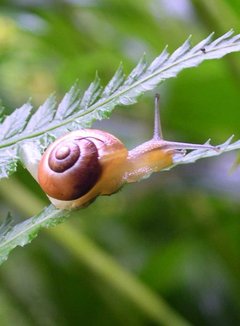Mollusk
|
|
- For the 1997 album by Ween, see The Mollusk.
| Mollusks | ||||||
|---|---|---|---|---|---|---|
| Roman snail (Helix pomatia) | ||||||
| Scientific classification | ||||||
| ||||||
| Classes | ||||||
|
Caudofoveata |
The mollusks or molluscs are the large and diverse phylum Mollusca, which includes a variety of familiar creatures well-known for their decorative shells or as seafood. These range from tiny snails and clams to the octopus and squid (which are considered the most intelligent invertebrates). The giant squid is the largest invertebrate, and, except for their larvae and some recently captured juveniles, has never been observed alive, although the Colossal Squid is likely to be even larger.
Mollusks are triploblastic protostomes. The principal body cavity is a blood-filled hemocoel, with an actual coelom present but reduced to vestiges around the hearts, gonads, and metanephridia (kidney-like organs). The body is divided into a head, often with eyes or tentacles, a muscular foot and a visceral mass housing the organs. Covering the body is a thick sheet called the mantle, which in most forms secretes a calcareous shell.
Mollusks have a mantle, which is a fold of the outer skin lining the shell, and a muscular foot that is used for motion. Many mollusks have their mantle produce a calcium carbonate external shell and their gill extracts oxygen from the water and disposes waste. All species of the phylum Mollusca have a complete digestive tract that starts from the mouth to the anus. Many have a radula, mostly composed of chitin, in the mouth, which allows then to scrape food from the surface by sliding back and forth. Mollusks also have a coelom, made from cell masses, where all organs are suspended. Unlike the closely related annelids, mollusks lack body segmentation.
Development passes through one or two trochophore stages, one of which (the veliger) is unique to the group. These suggest a close relationship between the mollusks and various other protostomes, notably the Annelids. Mollusk fossils are some of the best known and are found from the Cambrian onwards. There are eight living classes and one class, known only from fossils:
- Class Caudofoveata (deep-sea wormlike creatures; 70 known species); now generally recognized as a subclass of Aplacophora.
- Class Aplacophora (solenogasters, deep-sea wormlike creatures; 250 species)
- Class Polyplacophora (chitons; 600 species, rocky marine shorelines)
- Class Monoplacophora (deep-sea limpet-like creatures; 11 living species)
- Class Bivalvia (also Pelecypoda) (clams, oysters, scallops, mussels; 8,000 species)
- Class Scaphopoda (tusk shells; 350 species, all marine)
- Class Gastropoda (snails and slugs, limpets, sea hares; sea angel, sea butterfly, Sea Lemon; estimated 40,000 - 150,000 species)
- Class Cephalopoda (squids, octopuses, nautilus, cuttlefish; 786 species, all marine)
- Class † Rostroconchia (fossils; probably more than 1,000 species; probable ancestors of bivalves)
| Caudofoveata (?) | |||||
| Aplacophora | |||||
| hypothetical | Polyplacophora | ||||
| ancestral | Monoplacophora | ||||
| mollusk | Gastropoda | ||||
| Cephalopoda | |||||
| Bivalvia | |||||
| Scaphopoda |
Brusca & Brusca (1990) suggest that the bivalves and scaphopods are sister groups, as are the gastropods and cephalopods, so indicated in the relationship diagram above.
Malacology is the technical name for the scientific study of mollusks.
In this Phylum's level of organization, organ systems from all three primary germ layers can be found:
- Nervous System (with brain).
- Excretory System (nephridium or nephridia).
- Circulatory System (open).
- Respiratory System (gills or lungs).
- No skeletal system can be found.
See also
References
- Brusca & Brusca, 1990. Invertebrates, Sinauer Associates, Inc., Sunderland, Mass.
- Starr & Taggart, 2002. Biology: The Unity and Diversity of Life, Thomson Learning, inc., Pacific Grove, California.
- Conchology, Inc. (http://www.conchology.be)
- Mollusc Mollusk Mollusks 1999 (http://www.manandmollusc.net)bg:Мекотели
cs:Měkkýši da:Bløddyr de:Weichtiere et:Limused es:Molusco eo:Molusko fr:Mollusques ia:Mollusco it:Mollusca nl:Weekdier ja:軟体動物 pl:Mięczaki pt:Molusco ru:Моллюски sv:Blötdjur uk:Молюски zh:软体动物

